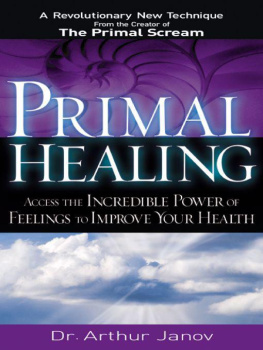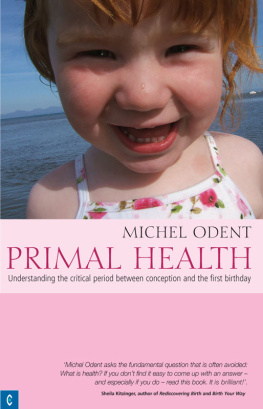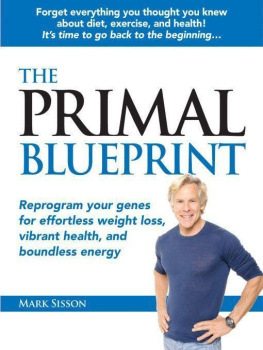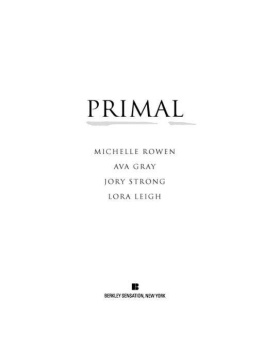Table of Contents
Copyright 2007 by Arthur Janov
All rights reserved under the Pan-American and International Copyright Conventions. This book may not be reproduced, in whole or in part, in any form or by any means electronic or mechanical, including photocopying, recording, or by any information storage and retrieval system now known or hereafter invented, without written permission from the publisher, The Career Press.
PRIMAL HEALING
TYPESET BY KATE HENCHES
Cover design by Lu Rossman/Digi Dog
Printed in the U.S.A. by Book-mart Press
To order this title, please call toll-free 1-800-CAREER-1 (NJ and Canada: 201-848- 0310) to order using VISA or MasterCard, or for further information on books from Career Press.
The Career Press, Inc., 3 Tice Road, PO Box 687,
Franklin Lakes, NJ 07417
www.careerpress.com
www.newpagebooks.com
Primal Therapy is dangerous in untrained hands. If you have any questions about those who claim to be Primal therapists please contact the Primal Center at primalctr@earthlink.net.
For information about proper Primal Therapy please see our Website: www.primaltherapy.com .
Library of Congress Cataloging-in-Publication Data
Janov, Arthur.
Primal healing : access to the incredible power of feelings to improve your health
: a revolutionary new therapy from the creator of Primal Scream / by Arthur Janov.
p. cm.
Includes bibliographical references (p. ).
ISBN-13: 978-1-56414-916-9 ISBN-10: 1-56414-916-1
1. Primal therapy. 2. EmotionsHealth aspects. I. Title.
RC489.P67J356 2006
615.5--dc22
2006012349
DEDICATION
Adieu,
Michael, Matt, Mimi, Nanou, Michel, Larry, Helmut, Eddie, Bernie, Jack, Marion.
ACKNOWLEDGMENTS
I want to thank Dr. Paul Thompson of the UCLA Neuroimaging Center for his help in my effort. Thank you, too, to Dr. David Goodman of the Newport Neuroscience Center for his contribution to my statements in neurology; also a word of thanks to Dr. Jonty Christie. My gratitude to Dr. Mike Makepeace, who was very helpful in improving the language in this book, as well as to my research assistant David Lassoff, who spent many hours verifying sometimes obscure references. Thank you to editor, Kathy Wyer, for her many hours of editorial help and also to Randy Malat, my editor for many years. Thanks go, as well, to Drs. Geoffrey Carr and Peter Prontzos for their valuable input. My thanks, finally, to editor Elizabeth Lyon, who really brought this book together, spending long hours refining it.
My deepest appreciation to my wife, Dr. France Janov, who read and reread these chapters offering invaluable insight along the way. As director of clinical training at our center she has helped develop the theory and techniques of the Primal approach. Her additions and corrections to what I write are everywhere throughout this book.
Finally, I want to thank my recently departed long-time colleague, neurologist Dr. Michael Holden, who nurtured my interest in neurology and taught me so much.
Design of three levels of consciousness image on page 59 by Dr. France Janov.
For more it is than I can well express
And that deep torture may be called a hell
When more is felt than one hath power to tell.
The Rape of Lucrece
Shakespeare
We must pursue the duty of memory to its conclusion.
Jacques Chirac, President of France
Memory is a duty.
And memory is medicine.
Dr. Arthur Janov
INTRODUCTION
As a clinical psychologist with more than 50 years in the field, Ive come to appreciate that if we are to effectively treat mental health problems, we must combine the best of both worlds and integrate the discipline of neuroscience with that of psychology. A deepening exchange is needed, a cross-pollination of knowledge and practice between these two fields.
In this book I shall try to fuse neurology, psychology, and biology into one organic whole so that we humans will no longer be dissected into separate parts for convenience of study. This will allow us to explain human beings in a truly holistic way, seeing how psychology interacts with neurology to determine our behavior and our symptoms. Thus, when we make a psychologic diagnosis it will also encompass other sciences, at the same time making a diagnosis of how our physical system works along with the emotional one. For example, we shall not only discuss obsessiveness but also where it occurs in the brain and what the factors were in history that gave it its start. And sexual impotencehow neurologic factors affect it, and where in the sufferers history experiences occurred that might have given rise to it later on. In this way, we shall cut across several disciplines to help us understand who we are, and how emotional factors affect the brain and body, and vice versa. We are of one piece. We can abstract different aspects of us for convenience of study, but the fact remains that we are one organic whole. At some point we have to put all of the pieces back together to provide holistic, organic answers for the human condition.
Those of us who have been trained extensively and practice Primal Therapy at the center believe that for the first time we are establishing the first science of psychotherapy. We videotape all sessions and we go over them. When a mistake is made we know it immediately because the therapy is precise and ordered. This was never the case when I practiced psychoanalytic psychotherapy. What this means is that we now have a systematic therapy that can truly make people better. I hesitate to use the word cure because it has an opprobrious connotation, but the fact is that in many cases that is exactly what happens. This is because we are able to probe into the depths of the brain and into the antipodes of the unconscious to ferret out traumatic elements that have lain there for decades, hidden and deep, doing all kinds of damage, affecting our behavior and what kind of ailments we shall suffer. I believe that this book is an avatar for our field equivalent to Sigmund Freuds 1902 Interpretation of Dreams , which laid out for the first time the nature of the unconscious and how it might affect us. We have a more detailed understanding of that unconscious now because we see it in therapy every day. We peer down into the past of our patients and see how ancient history evolved. We observe someone in therapy and begin to understand the history of mankind. We see patients reliving their pasts and observe our ancient past at the same time. We see the reptilian/salamander brain in action by observing the birth trauma and comprehending what it has done to us throughout our lives, from attention deficit disorder to migraines and high blood pressure. Without that understanding we shall never understand ourselves, much less treat those conditions effectively. That is saying a lot, but I hope that this book will clarify what I mean.
Because behavior and cognitive/insight therapies have focused solely on behavior for diagnosis and treatment, current research involving the brain has largely gone unnoticed. So although psychological theories abound, they lack an anchor in neuroscience, and neuroscience offers a wealth of information that can inform clinical practice. I propose creating a bridge between the two.
My attempt is one of the first steps toward this goal and not a final, definitive answer. Having had the privilege of many decades of clinical work, Ive observed how personality evolves, where neurosis begins, and learned where a cure lies. Thanks to neuroscience, we now have a vast body of knowledge to mine, a deeper more certain understanding of how the brain relates to behavior. Unlike years past, today we know a great deal more about the nature of feelings and the limbic system. Most importantly, we know how to rid the system of engraved, enduring pain.












